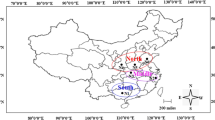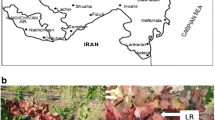Abstract
Phaeomoniella chlamydospora is one of the main causal agents of Petri disease and esca of grapevines. Although it is known to have a coelomycete synanamorph, no teleomorph has thus far been reported for P. chlamydospora, and its disease cycle remains largely unknown. The present study compared the genetic diversity of P. chlamydospora isolates from different grapevine-growing countries using amplified fragment length polymorphisms. Sixty-three isolates from South Africa and 25 from grapevine regions in Australia, France, Iran, Italy, New Zealand, Slovenia and the USA were studied. Two primer combinations were used producing 138 scorable markers, of which 33% were polymorphic. An unweighted paired group method of arithmetic averages analysis showed a high similarity (≥94.5%) among the different isolates. The overall low level of genetic variation confirmed asexual reproduction to be dominant in the field. Different genotypes were found among isolates of P. chlamydospora within the same grapevine, suggesting multiple infections from different inoculum sources. Isolates from different production areas and countries had a high percentage of similarity and clustered together, indicating the absence of genotype-geographic structure. The presence of the same genotype in different vineyards and production areas suggests that long-range dispersal through aerial inoculum or infected plant material play an important role in genotype distribution.
Similar content being viewed by others
References
Ari ME (2000) A general approach for esca disease in the vineyards of Turkey. Phytopathologia Mediterranea 39, 35–37.
Bertelli E, Mugnai L, Surico G (1998) Presence of Phaeoacremonium chlamydosporum in apparently healthy rooted grapevine cuttings. Phytopathologia Mediterranea 37, 79–82.
Borie B, Jacquiot L, Jamaux-Despréaux I, Larignon P, Péros J-P (2002) Genetic diversity in populations of the fungi Phaeomoniella chlamydospora and Phaeoacremonium aleophilum on grapevine in France. Plant Pathology 51, 85–96. doi: 10.1046/j.0032-0862.2001.658.x
Burdon JJ, Silk J (1997) Sources and patterns of diversity in plant-pathogenic fungi. Phytopathology 87, 664–669.
Chicau G, Aboim-Inglez M, Cabral S, Cabral JPS (2000) Phaeoacremonium chlamydosporum and Phaeoacremonium angustius associated with esca and grapevine decline of Vinho Verde grapevines in northwest Portugal. Phytopathologia Mediterranea 39, 80–86.
Cortesi P, Fischer M, Milgroom MG (2002) Identification and spread of Fomitiporia punctata associated with wood decay of grapevine showing symptoms of esca. Phytopathology 90, 967–972.
Crous PW, Gams W (2000) Phaeomoniella chlamydospora gen. et comb. nov., a causal organism of Petri grapevine decline and esca. Phytopathology Mediterranea 39, 112–118.
Crous PW, Swart L, Coertze S (2001) The effect of hot-water treatment on fungi occurring in apparently healthy grapevine cuttings. Phytopathologia Mediterranea 40, S464-S466.
De Blij HJ (1983) ‘Wine, a geographic appreciation.’ (Rowman & Allanheld Publishers: Totowa)
Edwards J, Pascoe I (2004) Occurrence of Phaeomoniella chlamydospora and Phaeoacremonium aleophilum associated with Petri disease and esca in Australian grapevines. Australasian Plant Pathology 33, 273–279. doi: 10.1071/AP04016
Edwards J, Marchi G, Pascoe I (2001) Young esca in Australia. Phytopathologia Mediterranea 40, S303-S310.
Eskalen A, Gubler WD (2001) Association of spores of Phaeomoniella chlamydospora, Phaeoacremonium inflatipes, and Pm. aleophilum with grapevine cordons in California. Phytopathologia Mediterranea 40, S429-S432.
Feliciano AJ, Gubler WD (2001) Histological investigations on infection of grape roots and shoots by Phaeoacremonium spp. Phytopathologia Mediterranea 40, S387-S393.
Feliciano AJ, Eskalen A, Gubler WD (2004) Differential susceptibility of three grapevine cultivars to Phaeoacremonium aleophilum and Phaeomoniella chlamydospora in California. Phytopathologia Mediterranea 43, 66–69.
Fischer M (2002) A new wood-decaying basidiomycete species associated with esca of grapevine: Fomitiporia mediterranea (Hymenochaetales). Mycological Progress 1, 315–324. doi: 10.1007/s11557-006-0029-4
Fourie PH, Halleen F (2004) Proactive control of Petri Disease of grapevine through treatment of propagation material. Plant Disease 88, 1241–1245.
Gräfenhan T, Zare R, Gams W (2005) Esca — a disease or a case of commensalism? In ‘Proceedings of the 4th International Workshop on Grapevine Trunk Diseases’. p. 62. (University of Stellenbosch: Stellenbosch)
Groenewald M, Kang J-C, Crous PW, Gams W (2001) ITS and beta-tubulin phylogeny of Phaeoacremonium and Phaeomoniella species. Mycological Research 105, 651–657. doi: 10.1017/S0953756201004282
Larignon P, Dubos B (1997) Fungi associated with esca disease in grapevine. European Journal of Plant Pathology 103, 147–157. doi: 10.1023/A:1008638409410
Lorena T, Calamassi R, Mori B, Mugnai L, Surico G (2001) Phaeomoniella chlamydospora — grapevine interaction: histochemical reactions to fungal infection. Phytopathologia Mediterrenea 40, S400-S406.
Morton L (2000) Viticulture and grapevine declines: lessons of black goo. Phytopathologia Mediterranea 39, 59–67.
Mostert L, Groenewald JZ, Summerbell RC, Robert V, Sutton DA, Padhye AA, Crous PW (2005) Species of Phaeoacremonium associated with human infections and environmental reservoirs in infected woody plants. Journal of Clinical Microbiology 43, 1752–1767. doi: 10.1128/JCM.43.4.1752-1767.2005
Mugnai L, Graniti A, Surico G (1999) Esca (black measles) and brown wood-streaking: two old and elusive diseases of grapevines. Plant Disease 83, 404–416.
Pascoe I, Cottral E (2000) Developments in grapevine trunk diseases research in Australia. Phytopathologia Mediterranea 39, 68–75.
Pottinger B, Stewart A, Carpenter M, Ridgway HJ (2002) Low genetic variation detected in New Zealand populations of Phaeomoniella chlamydospora. Phytopathologia Mediterranea 41, 199–211.
Scheck HJ, Vasquez SJ, Gubler WD (1998) First report of three Phaeoacremonium spp. causing young grapevine decline in California. Plant Disease 82, 590.
Schoustra SE (2004) Reducing fitness costs associated with antibiotic resistance — experimental evolution in the filamentous fungus, Aspergillus nidulans. PhD thesis, University of Wageningen, Wageningen, The Netherlands.
Sparapano L, Bruno G, Ciccarone C, Graniti A (2000) Infection of grapevines by some fungi associated with esca. II. Interaction among Phaeoacremonium chlamydosporum, P. aleophilum and Fomitiporia punctata. Phytopathologia Mediterranea 39, 53–58.
Tegli S, Santilli E, Bertelli E, Surico G (2000) Genetic variation within Phaeoacremonium aleophilum and P. chlamydosphorum in Italy. Phytopathologia Mediterranea 39, 125–133.
Unwin T (1991) ‘Wine and the vine, an historical geography of viticulture and the wine trade.’ (Routledge: New York)
Vos P, Hogers R, Bleeker M, Reijans M, van de Lee T, et al. (1995) AFLP: a new technique for DNA fingerprinting. Nucleic Acids Research 23, 4407–4414.
Weaver RJ (1976) ‘Grape growing.’ (John Wiley & Sons: New York)
Author information
Authors and Affiliations
Corresponding author
Rights and permissions
About this article
Cite this article
Mostert, L., Abeln, E.C.A., Halleen, F. et al. Genetic diversity among isolates of Phaeomoniella chlamydospora on grapevines. Australasian Plant Pathology 35, 453–460 (2006). https://doi.org/10.1071/AP06047
Received:
Accepted:
Issue Date:
DOI: https://doi.org/10.1071/AP06047




